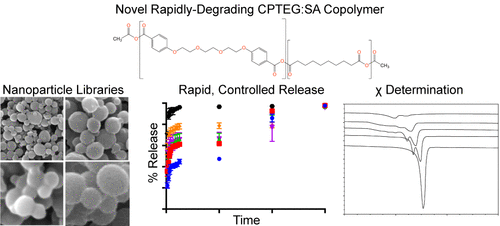当前位置:
X-MOL 学术
›
ACS Comb. Sci.
›
论文详情
Our official English website, www.x-mol.net, welcomes your feedback! (Note: you will need to create a separate account there.)
High-Throughput Synthesis and Screening of Rapidly Degrading Polyanhydride Nanoparticles.
ACS Combinatorial Science ( IF 3.903 ) Pub Date : 2020-03-11 , DOI: 10.1021/acscombsci.9b00162 Adam S Mullis 1 , Sarah J Jacobson 1 , Balaji Narasimhan 1
ACS Combinatorial Science ( IF 3.903 ) Pub Date : 2020-03-11 , DOI: 10.1021/acscombsci.9b00162 Adam S Mullis 1 , Sarah J Jacobson 1 , Balaji Narasimhan 1
Affiliation

|
Combinatorial techniques can accelerate the discovery and development of polymeric nanodelivery devices by pairing high-throughput synthesis with rapid materials characterization. Biodegradable polyanhydrides demonstrate tunable release, high cellular internalization, and dose sparing properties when used as nanodelivery devices. This nanoparticle platform shows promising potential for small molecule drug delivery, but the pace of understanding and rational design of these nanomedicines is limited by the low throughput of conventional characterization. This study reports the use of a high-throughput method to synthesize libraries of a newly synthesized, rapidly eroding polyanhydride copolymer based on 1,8-bis(p-carboxyphenoxy)-3,6-dioxaoctane (CPTEG) and sebacic acid (SA) monomers. The high-throughput method enabled efficient screening of copolymer microstructure, revealing weak block-type and alternating architectures. The high-throughput method was adapted to synthesize nanoparticle libraries encapsulating hydrophobic model drugs. Drug release from these nanoparticles was rapid, with a majority of the payload released within 3 days. Drug release was dramatically slowed at acidic pH, which could be useful for oral drug delivery. Rhodamine B (RhoB) release kinetics generally followed patterns of polymer erosion kinetics, while Coomassie brilliant blue (CBB) released the fastest from the slowest degrading polymer chemistry and vice versa. These differences in trends between copolymer chemistry and release kinetics were hypothesized to arise from differences in mixing thermodynamics. A high-throughput method was developed to synthesize polymer-drug film libraries and characterize mixing thermodynamics by melting point depression. Rhodamine B had a negative χ for all copolymers with <30 mol % CPTEG tested, indicating a tendency toward miscibility. By contrast, CBB χ increased, eventually becoming positive near 15:85 CPTEG:SA, with increasing CPTEG content. This indicates an increasing tendency toward phase separation in CPTEG-rich copolymers. These in vitro results screening polymer-drug interactions showed good agreement with in silico predictions from Hansen solubility parameter estimation and were able to explain the observed differences in model drug release trends.
中文翻译:

高通量合成和快速降解聚酸酐纳米粒子的筛选。
组合技术可以通过将高通量合成与快速的材料表征相结合来加速聚合物纳米传递装置的发现和开发。当用作纳米传递装置时,可生物降解的聚酸酐表现出可调的释放,高的细胞内在化和节省剂量的特性。该纳米颗粒平台显示出小分子药物递送的有希望的潜力,但是这些纳米药物的理解和合理设计的步伐受到常规表征的低通量的限制。这项研究报告了使用高通量方法来合成基于1,8-双(对羧基苯氧基)-3,6-二氧八辛烷(CPTEG)和癸二酸(SA)的新合成的快速侵蚀的聚酸酐共聚物的文库单体。高通量方法能够有效筛选共聚物的微观结构,揭示出弱嵌段型和交替结构。高通量方法适用于合成封装疏水模型药物的纳米粒子库。这些纳米颗粒的药物释放迅速,大部分有效载荷在3天内释放。在酸性pH值下,药物的释放明显减慢,这可能对口服药物传递有用。罗丹明B(RhoB)的释放动力学通常遵循聚合物侵蚀动力学的模式,而考马斯亮蓝(CBB)的释放速度最慢,而降解速度最慢,而反之亦然。共聚物化学和释放动力学之间趋势的这些差异被认为是由于混合热力学的差异引起的。开发了一种高通量方法来合成聚合物-药物膜库并通过降低熔点来表征混合热力学。罗丹明B在所有测试的CPTEG <30 mol%的共聚物中,χ均为负,表明有混溶性。相反,随着CPTEG含量的增加,CBBχ增加,最终在15:85 CPTEG:SA附近变为阳性。这表明在富含CPTEG的共聚物中相分离的趋势有所增加。这些体外筛选聚合物-药物相互作用的结果显示,与Hansen溶解度参数估计的计算机模拟预测吻合良好,并且能够解释模型药物释放趋势中观察到的差异。罗丹明B在所有测试的CPTEG <30 mol%的共聚物中,χ均为负,表明有混溶性。相反,随着CPTEG含量的增加,CBBχ增加,最终在15:85 CPTEG:SA附近变为阳性。这表明在富含CPTEG的共聚物中相分离的趋势有所增加。这些体外筛选聚合物-药物相互作用的结果显示,与Hansen溶解度参数估算的计算机模拟预测具有良好的一致性,并且能够解释模型药物释放趋势中观察到的差异。罗丹明B在所有测试的CPTEG <30 mol%的共聚物中,χ均为负,表明有混溶性。相反,随着CPTEG含量的增加,CBBχ增加,最终在15:85 CPTEG:SA附近变为阳性。这表明在富含CPTEG的共聚物中相分离的趋势有所增加。这些体外筛选聚合物-药物相互作用的结果显示,与Hansen溶解度参数估算的计算机模拟预测具有良好的一致性,并且能够解释模型药物释放趋势中观察到的差异。
更新日期:2020-04-23
中文翻译:

高通量合成和快速降解聚酸酐纳米粒子的筛选。
组合技术可以通过将高通量合成与快速的材料表征相结合来加速聚合物纳米传递装置的发现和开发。当用作纳米传递装置时,可生物降解的聚酸酐表现出可调的释放,高的细胞内在化和节省剂量的特性。该纳米颗粒平台显示出小分子药物递送的有希望的潜力,但是这些纳米药物的理解和合理设计的步伐受到常规表征的低通量的限制。这项研究报告了使用高通量方法来合成基于1,8-双(对羧基苯氧基)-3,6-二氧八辛烷(CPTEG)和癸二酸(SA)的新合成的快速侵蚀的聚酸酐共聚物的文库单体。高通量方法能够有效筛选共聚物的微观结构,揭示出弱嵌段型和交替结构。高通量方法适用于合成封装疏水模型药物的纳米粒子库。这些纳米颗粒的药物释放迅速,大部分有效载荷在3天内释放。在酸性pH值下,药物的释放明显减慢,这可能对口服药物传递有用。罗丹明B(RhoB)的释放动力学通常遵循聚合物侵蚀动力学的模式,而考马斯亮蓝(CBB)的释放速度最慢,而降解速度最慢,而反之亦然。共聚物化学和释放动力学之间趋势的这些差异被认为是由于混合热力学的差异引起的。开发了一种高通量方法来合成聚合物-药物膜库并通过降低熔点来表征混合热力学。罗丹明B在所有测试的CPTEG <30 mol%的共聚物中,χ均为负,表明有混溶性。相反,随着CPTEG含量的增加,CBBχ增加,最终在15:85 CPTEG:SA附近变为阳性。这表明在富含CPTEG的共聚物中相分离的趋势有所增加。这些体外筛选聚合物-药物相互作用的结果显示,与Hansen溶解度参数估计的计算机模拟预测吻合良好,并且能够解释模型药物释放趋势中观察到的差异。罗丹明B在所有测试的CPTEG <30 mol%的共聚物中,χ均为负,表明有混溶性。相反,随着CPTEG含量的增加,CBBχ增加,最终在15:85 CPTEG:SA附近变为阳性。这表明在富含CPTEG的共聚物中相分离的趋势有所增加。这些体外筛选聚合物-药物相互作用的结果显示,与Hansen溶解度参数估算的计算机模拟预测具有良好的一致性,并且能够解释模型药物释放趋势中观察到的差异。罗丹明B在所有测试的CPTEG <30 mol%的共聚物中,χ均为负,表明有混溶性。相反,随着CPTEG含量的增加,CBBχ增加,最终在15:85 CPTEG:SA附近变为阳性。这表明在富含CPTEG的共聚物中相分离的趋势有所增加。这些体外筛选聚合物-药物相互作用的结果显示,与Hansen溶解度参数估算的计算机模拟预测具有良好的一致性,并且能够解释模型药物释放趋势中观察到的差异。



























 京公网安备 11010802027423号
京公网安备 11010802027423号